Abstract
Entamoeba histolytica HM1 supported the activation of human alternative and classical complement pathways in the absence of ameba-reactive antibodies. Nonimmune serum depleted of C1q and factor D (NHS s C1q + D) and reconstituted with C1q was able to specifically deposit C3b onto trophozoites and produce lysis. This activity was not modified by the absorption of serum on E. histolytica. Serum depleted of factor B allowed C3b binding to amebae. Serum devoid of C4 effected only small amounts of C3 uptake. The kinetics of lysis of E. histolytica by serum in the presence of Mg-EGTA [ethylene glycol-bis(beta-aminoethyl ether)-N,N,N',N'-tetraacetic acid] (lacking classical pathway function) or by NHS s C1q + D and reconstituted with factor D was slow and only produced one-half the amount of lysis produced by NHS s C1q + D supplemented with C1q. These results indicate that the surface of the ameba can promote complement activation by the classical pathway, without the participation of specific antibodies, and that the magnitude of this activation is greater than that induced by the alternative pathway.
Full text
PDF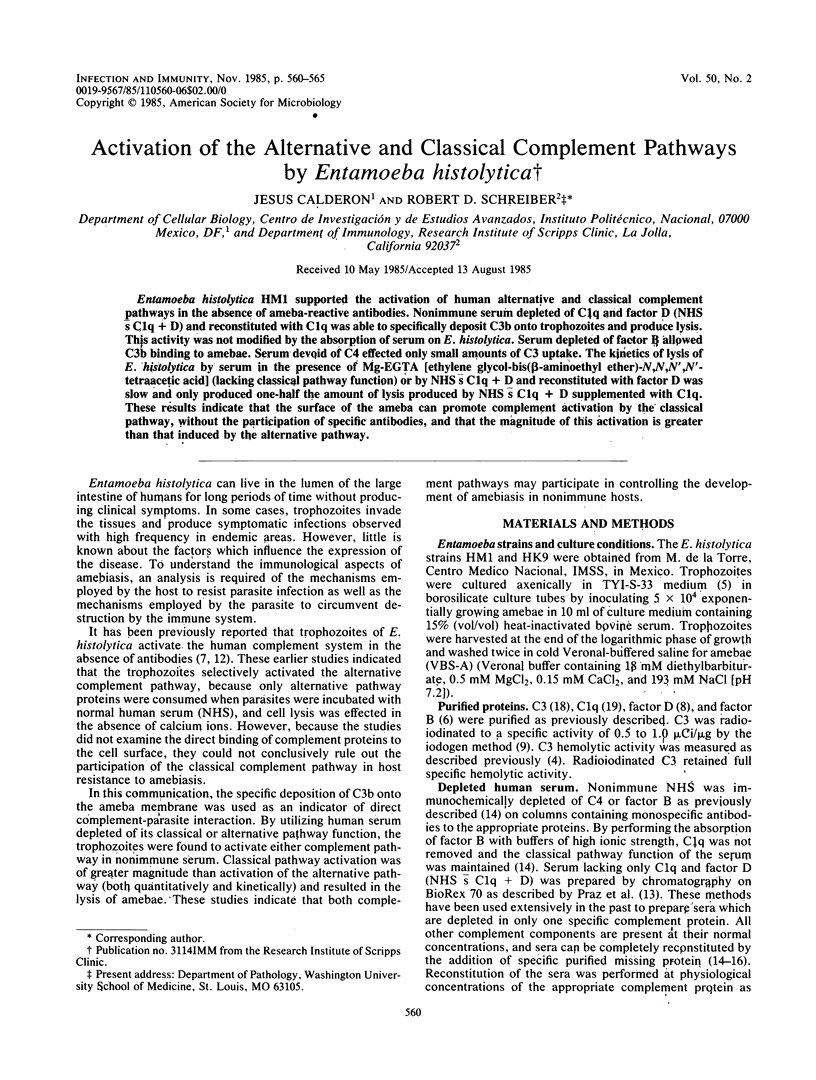
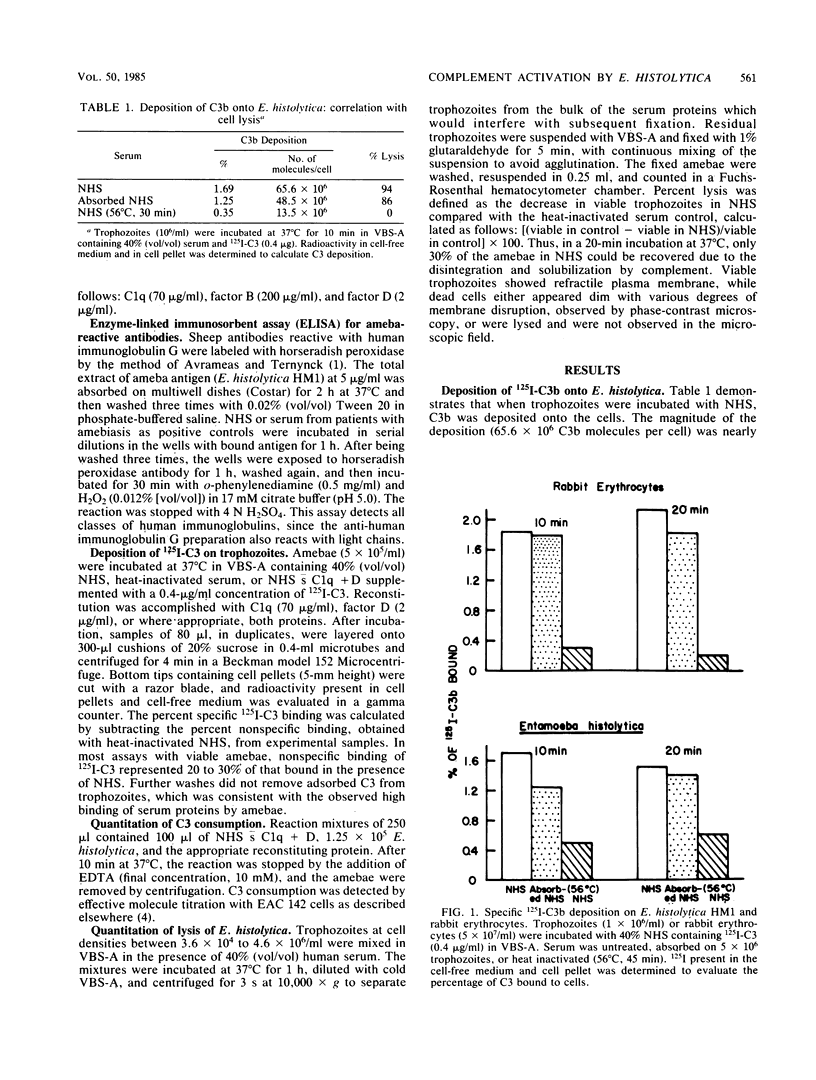
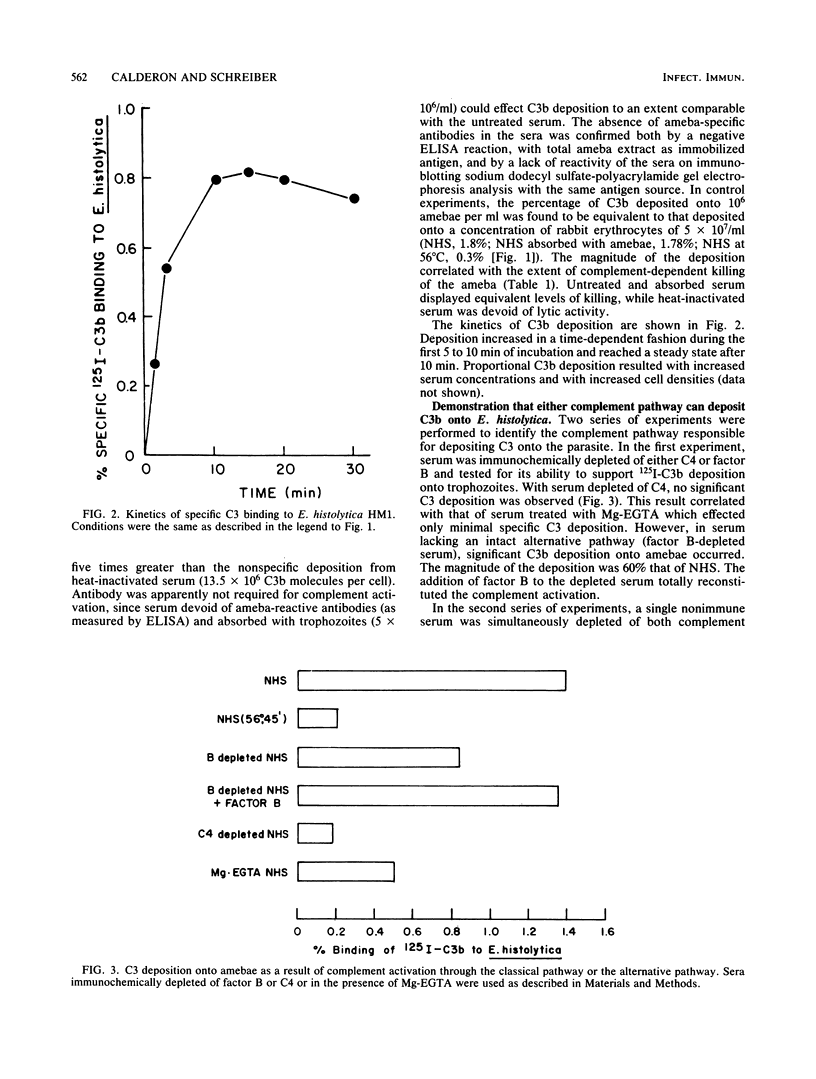
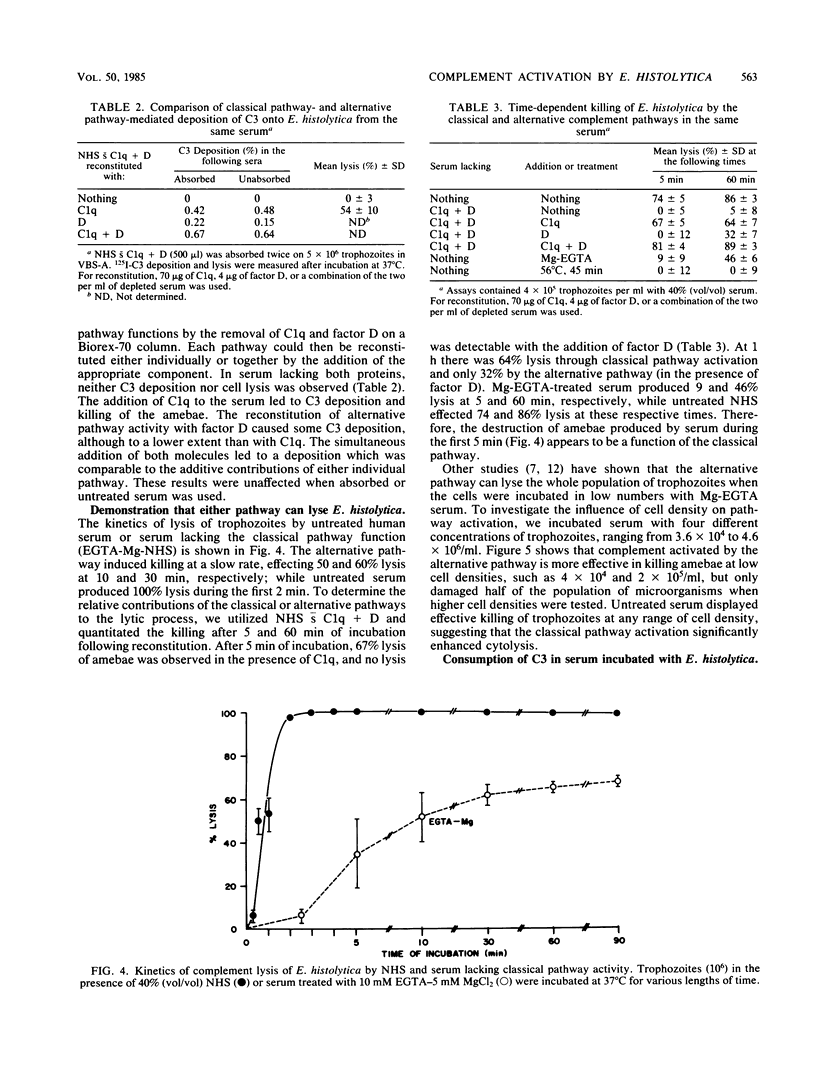
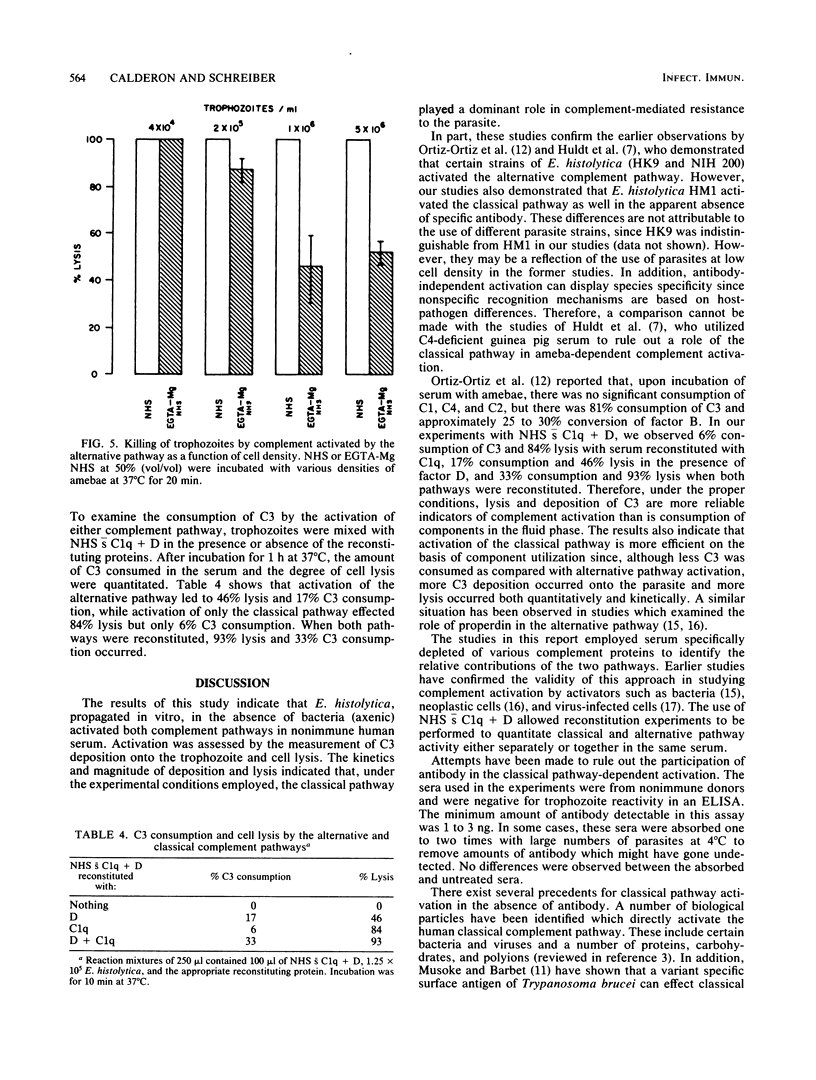
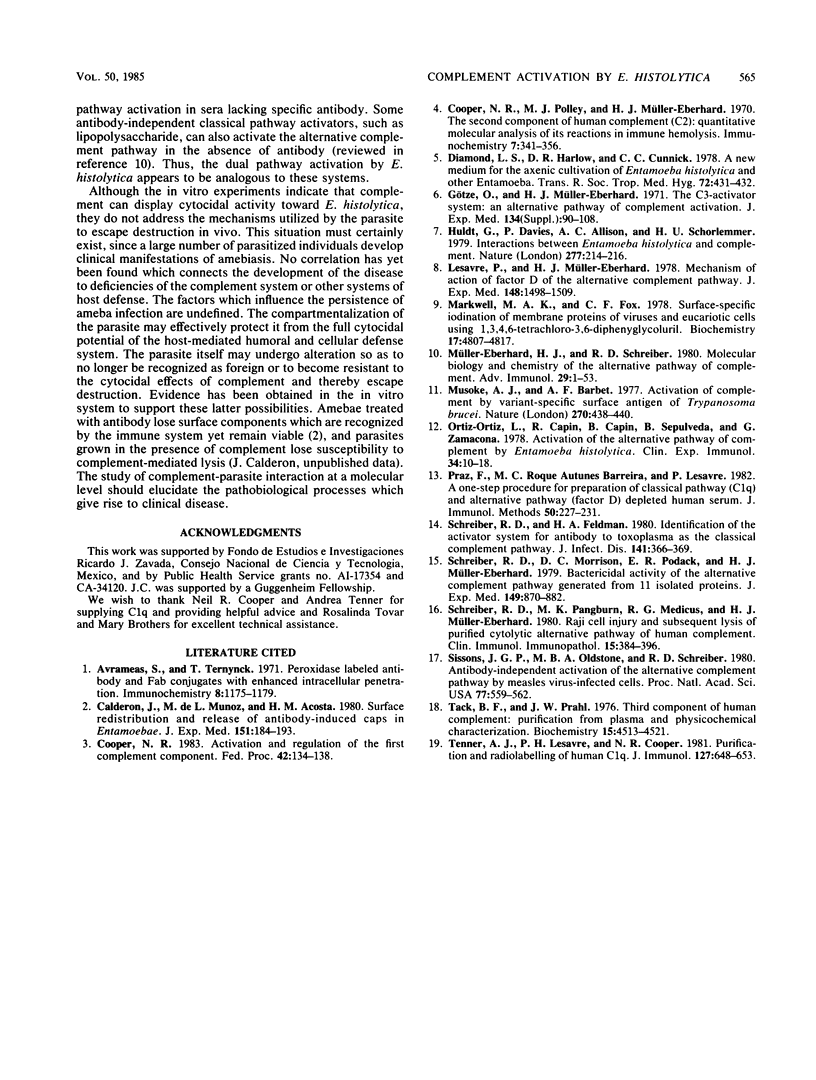
Selected References
These references are in PubMed. This may not be the complete list of references from this article.
- Avrameas S., Ternynck T. Peroxidase labelled antibody and Fab conjugates with enhanced intracellular penetration. Immunochemistry. 1971 Dec;8(12):1175–1179. doi: 10.1016/0019-2791(71)90395-8. [DOI] [PubMed] [Google Scholar]
- Calderón J., de Lourdes Muñoz M., Acosta H. M. Surface redistribution and release of antibody-induced caps in entamoebae. J Exp Med. 1980 Jan 1;151(1):184–193. doi: 10.1084/jem.151.1.184. [DOI] [PMC free article] [PubMed] [Google Scholar]
- Cooper N. R. Activation and regulation of the first complement component. Fed Proc. 1983 Jan;42(1):134–138. [PubMed] [Google Scholar]
- Cooper N. R., Polley M. J., Müller-Eberhard H. J. The second component of human complement (C2): quantitative molecular analysis of its reactions in immune hemolysis. Immunochemistry. 1970 Apr;7(4):341–356. doi: 10.1016/0019-2791(70)90237-5. [DOI] [PubMed] [Google Scholar]
- Diamond L. S., Harlow D. R., Cunnick C. C. A new medium for the axenic cultivation of Entamoeba histolytica and other Entamoeba. Trans R Soc Trop Med Hyg. 1978;72(4):431–432. doi: 10.1016/0035-9203(78)90144-x. [DOI] [PubMed] [Google Scholar]
- Götze O., Müller-Eberhard H. J. The c3-activator system: an alternate pathway of complement activation. J Exp Med. 1971 Sep 1;134(3):90–108. [PMC free article] [PubMed] [Google Scholar]
- Huldt G., Davies P., Allison A. C., Schorlemmer H. U. Interactions between Entamoeba histolytica and complement. Nature. 1979 Jan 18;277(5693):214–216. doi: 10.1038/277214a0. [DOI] [PubMed] [Google Scholar]
- Lesavre P. H., Müller-Eberhard H. J. Mechanism of action of factor D of the alternative complement pathway. J Exp Med. 1978 Dec 1;148(6):1498–1509. doi: 10.1084/jem.148.6.1498. [DOI] [PMC free article] [PubMed] [Google Scholar]
- Markwell M. A., Fox C. F. Surface-specific iodination of membrane proteins of viruses and eucaryotic cells using 1,3,4,6-tetrachloro-3alpha,6alpha-diphenylglycoluril. Biochemistry. 1978 Oct 31;17(22):4807–4817. doi: 10.1021/bi00615a031. [DOI] [PubMed] [Google Scholar]
- Musoke A. J., Barbet A. F. Activation of complement by variant-specific surface antigen of trypanosoma brucei. Nature. 1977 Dec 1;270(5636):438–440. doi: 10.1038/270438a0. [DOI] [PubMed] [Google Scholar]
- Müller-Eberhard H. J., Schreiber R. D. Molecular biology and chemistry of the alternative pathway of complement. Adv Immunol. 1980;29:1–53. doi: 10.1016/s0065-2776(08)60042-5. [DOI] [PubMed] [Google Scholar]
- Ortiz-Ortiz L., Capin R., Capin N. R., Sepúlveda B., Zamacona G. Activation of the alternative pathway of complement by Entamoeba histolytica. Clin Exp Immunol. 1978 Oct;34(1):10–18. [PMC free article] [PubMed] [Google Scholar]
- Praz F., Roque Antunes Barreira M. C., Lesavre P. A one-step procedure for preparation of classical pathway (C1q) and alternative pathway (factor D) depleted human serum. J Immunol Methods. 1982;50(2):227–231. doi: 10.1016/0022-1759(82)90229-0. [DOI] [PubMed] [Google Scholar]
- Schreiber R. D., Feldman H. A. Identification of the activator system for antibody to Toxoplasma as the classical complement pathway. J Infect Dis. 1980 Mar;141(3):366–369. doi: 10.1093/infdis/141.3.366. [DOI] [PubMed] [Google Scholar]
- Schreiber R. D., Morrison D. C., Podack E. R., Müller-Eberhard H. J. Bactericidal activity of the alternative complement pathway generated from 11 isolated plasma proteins. J Exp Med. 1979 Apr 1;149(4):870–882. doi: 10.1084/jem.149.4.870. [DOI] [PMC free article] [PubMed] [Google Scholar]
- Schreiber R. D., Pangburn M. K., Medicus R. G., Müller-Eberhard H. J. Raji cell injury and subsequent lysis by the purified cytolytic alternative pathway of human complement. Clin Immunol Immunopathol. 1980 Mar;15(3):384–396. doi: 10.1016/0090-1229(80)90050-1. [DOI] [PubMed] [Google Scholar]
- Sissons J. G., Oldstone M. B., Schreiber R. D. Antibody-independent activation of the alternative complement pathway by measles virus-infected cells. Proc Natl Acad Sci U S A. 1980 Jan;77(1):559–562. doi: 10.1073/pnas.77.1.559. [DOI] [PMC free article] [PubMed] [Google Scholar]
- Tack B. D., Prahl J. W. Third component of human complement: purification from plasma and physicochemical characterization. Biochemistry. 1976 Oct 5;15(20):4513–4521. doi: 10.1021/bi00665a028. [DOI] [PubMed] [Google Scholar]
- Tenner A. J., Lesavre P. H., Cooper N. R. Purification and radiolabeling of human C1q. J Immunol. 1981 Aug;127(2):648–653. [PubMed] [Google Scholar]


